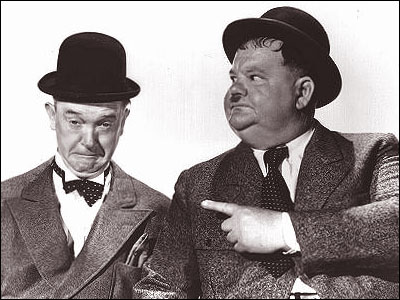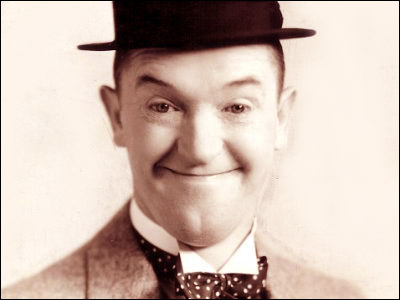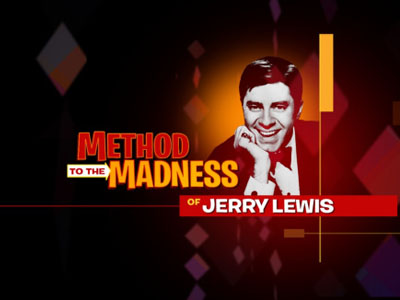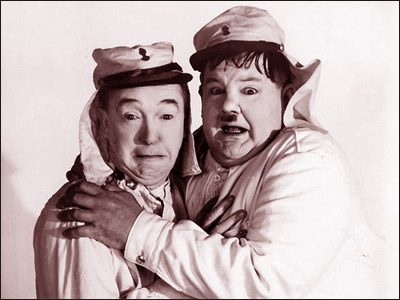We love clips of Allan Sherman on this blog. Here from a 1965 special he did is a little segment with the British group Herman's Hermits and its leader, Peter Noone…

We love clips of Allan Sherman on this blog. Here from a 1965 special he did is a little segment with the British group Herman's Hermits and its leader, Peter Noone…

The late Bob Clampett directed great cartoons and was later a great repository of cartoon history. In the early seventies when most of his old co-workers couldn't be bothered to answer questions about "the old days," he was accessible and friendly to all. More to the point, he had a good memory and an amazing stash of stuff he'd saved — much of it reportedly fished out of wastebaskets and not necessarily his — to supplement his recollections. From time to time, he'd invite local animation buffs up to his dwelling in the Hollywood Hills just to watch his old cartoons and talk about them. One of the times I was so privileged, he ran his 1944 Merry Melody Russian Rhapsody and one of the young animators present asked Bob how a certain bit of animation — an unusual effect — had been done. Bob excused himself, disappeared into an off-limits room in his home, then returned with the actual cels and animation drawings for that sequence and proceeded to explain.
Animation historian Michael Barrier was one of the folks who tapped into Clampett's grand memory and archives. That Bob was often inflating his own role was inarguable to the point where he eventually joked about it. One time when we were lunching, he asked me, "Did I ever tell you how I invented the grilled cheese sandwich?" He was hardly the only one of his contemporaries to spin history in his own direction…as many did once Bob's interviews prompted them to agree to their own. At times, it almost seemed like if you worked in the Warner Brothers cartoon studio within a year either way of the birth of Bugs Bunny, you had to claim fathership. No one's tale of how they'd created the wabbit was uniquely believable and Bob eventually had to walk his (and a few other such assertions) back a few blocks. But if you could get around that with most of those guys and apply a little skepticism, there was much to be learned. You also had to deal with the fact that some of them hated each other and it was not always easy to remain friends with both sides.
At one point, Clampett marked up a map of Los Angeles for Barrier and on it, he tried to pinpoint where certain moments in cartoon lore had occurred. Being a sucker for the history of both animation and old L.A., I was naturally fascinated. That map has now been scanned for posterity and the Internet and Michael is sharing it over at his website.
Number ninety-five in a series…

This is an add-on to the previous post. It occurs to me that the Mad, Mad, Mad Comedians special-pilot starts with and really features the Smothers Brothers…who at the time this aired (4/70) had been booted off CBS despite pretty good ratings. This leads me to suspect that the show was produced at least a year before it aired. I mean, if you were a TV producer, would you want to be shopping around a pilot starring two guys who'd just been kicked off network television because right-wing advertisers didn't want them on? The Brothers went off in September of '69 but their cancellation was final some time before that and looming in the previous months. Also, a year or so before, Flip Wilson was pretty hot and all the networks were courting him for a series. His NBC one went on the air in September of 1970.
Within the animation industry, there was a long, checkered history of proposed cartoon shows built around the Marx Brothers. For a time there, every time I turned around, a different producer either had the rights, thought he had the rights or was pitching the idea with the hope that he could secure the rights. My friend Earl Kress wrote an entire pilot for Filmation and not long after that failed to go anywhere, I was approached by another producer (not anyone you've ever heard of) who said he was "making a deal" with whoever you'd make a deal with for such things. He wanted me to write the pilot for his Marx Brothers cartoon series but there was a catch: No Groucho. He had the rights to use Chico and Harpo and he thought he could get Zeppo ("How expensive could he be?") if I thought Zeppo's inclusion would make up for the absence of the guy with the mustache. I told him it would be like hearing "I Heard It Through The Grapevine" performed by Pips only.
Here's an unusual animated special that the folks at Rankin-Bass produced in 1970 — or at least it aired in April of that year. It was called The Mad, Mad, Mad Comedians and I believe it was intended as the pilot for a series. The idea was that each week, the antics of a bevy of great funnymen and women — some from the past, some from the present — would be animated. This was the only episode produced and it featured Jack Benny, George Burns, Phyllis Diller, Flip Wilson, The Smothers Brothers, Henny Youngman, W.C. Fields, George Jessel, Jack E. Leonard and the Marx Brothers. Most of the voices were done for this show by the comedians themselves, though the Flip Wilson and Smothers Brothers material is from those gents' records.
The most interesting segment is probably the one with the Marx Brothers for which Groucho recorded his own voice. Paul Frees, who's also heard as the announcer throughout, did the voices of Chico and Zeppo with Joan Gardner as the Empress, and the script is adapted from I'll Say She Is, the first show the brothers did on Broadway. Later on, Mr. Frees impersonated W.C. Fields for a segment that used a chunk of one of Fields's classic routines.
The caricatures of all these folks were done by Bruce Stark, who was a sports cartoonist for a couple of decades for the New York Daily News and later branched out into drawing for all the major magazines, including MAD. His work was seen a lot in TV Guide back when everyone read TV Guide, as opposed to now when no one reads TV Guide. Likenesses aren't easy and it's particularly difficult to do them in a style simple enough for animation. I'd say Mr. Stark did a great job. What I suspect caused this to remain unsold as a pilot was the disjointed nature of the program…and the frequent repetition of the annoying theme didn't help. But see what you think.
This video is in two parts which should play one after the other in the player I've embedded below. The Marx segment starts around 11:10 into the first part and continues into the second…

In the letter mentioned in the previous posting, Groucho Marx wrote to a Corporal Jerome G. Darrow who was stationed in Surinam in 1943.
A reader of this site, Brad Ferguson, was curious as to what became of Corporal Darrow and did a bit o' Googling. This would appear to be his gravesite, meaning that he survived the war, lived to the age of 73 and received a number of promotions along the way. I guess that's a happy ending. Nice detective work, Brad.
Groucho Marx writes a morale-boosting note to the troops in 1943. Thanks to Devlin Thompson for the link.
Number 94 in a series…

We often shill here for the Reprise! theater group which stages dandy, short-run productions of classic musicals up at UCLA. This year's season was supposed to consist of Cabaret followed by The Baker's Wife and then The Apple Tree.
Their Cabaret, which I reviewed here, was superb. But now they've announced that The Baker's Wife, which was to have run February 14 through 26 of '12, will not take place and there will be no replacement show in its place. Put simply, ticket sales and fundraising drives have been insufficient. Subscribers are being offered refunds with the hint that they could instead donate that money to Reprise! The Apple Tree is still scheduled to be produced in April.
This is very sad news for lovers of good theater in Los Angeles. I didn't think this year's choice of shows was as strong as some…but if Reprise! with its track record for delivering quality on stage isn't making it these days, that's a bad sign for all. Very bad.

I like Jerry Lewis. I like him enough that when he made his Broadway debut in Damn Yankees, my friend Paul Dini and I flew back just to be in the audience for opening night.
I like the guy but to be a Jerry Lewis fan is to cringe often at the man's excesses, ramblings, self-serving statements, angry lash-outs at those he thinks have wronged him, etc. On that great new boxed DVD set of Laurel and Hardy films (this one), he babbles on about their history, getting it all wrong, apparently unaware that there are in this world people who actually know the truth. If someone had made so many errors telling the story of Martin and Lewis, he'd have been furious…but he just goes on and on doing this stuff. Given that he's 85, you might excuse it because of age. Trouble is, he's been like this all his life.
Jerry Lewis: Method to the Madness is the new two-hour documentary that's now playing on the Encore channel. What's wrong with it is summarized in the second on-screen title card at the end — an Executive Producer credit for Jerry Lewis. I don't know how much he actually did on it or what kind of freedom filmmaker Gregg Barson had, but you wish someone could or would tell Jerry, "Uh, it isn't a great idea to announce you were the top guy in charge of an overexcessive tribute to yourself."
Not only that but it's a tribute that so deifies its subject that the mortal can't measure up to the hype. The clips of his work do not demonstrate the brilliance described by the talking heads that range from Jerry Seinfeld's to Carol Burnett's. There may be no clips in the world by anyone that would. I can well imagine younger folks, unfamiliar with Lewis's body of work, watching this, hearing of his comedic genius…and then wondering what's so spectacular about wedging the entire mouth of a drinking glass in your mouth for half a century. All the material of Lewis on-stage in his eighties is a little sad in that way.
The film is primarily about Jerry's work, as opposed to his off-stage life, though there are exceptions such as the looks at his relationship with his father. In both categories — personal and professional — the good parts are mentioned and the bad parts are hurried past or in most cases, omitted altogether. There's plenty about how Jerry's successful films were successful; almost nothing about how or why they eventually stopped being successful. The superstar days of Martin and Lewis are dwelled upon in depth; very little about how or why they ended. There's the great moment of the reunion on the Muscular Dystrophy Telethon; almost nothing about criticisms of the telethon and zero about Jerry's ouster from it. Lewis has had many hills and many valleys but in this overview of the man, it's nearly all hills. Nothing about The Day the Clown Cried. Nothing about Jerry's failed TV projects or the Jerry Lewis Cinemas. There's Carol Burnett talking about the greatness of Jerry; nothing about his occasional statements that female comedians, Carol Burnett included, are never funny.
Why in two hours of telling us what a legend he was and is, wasn't there time for that? Most viewers, even before they see Jerry's Exec Producer credit, will leap to a simple assumption. The filmmaker wouldn't have gotten his "unlimited access" (as it was called in the press releases) if he'd wanted to visit the valleys.
We've had a number of these "life of great comedian" documentaries lately. I thought the one about Don Rickles had some of the same problems of fawning that the Jerry Lewis one had, though not as many…and it fawned over Rickles as a guy who was great on a Vegas stage, as opposed to a guy who revolutionized comedy and filmmaking. The one about Joan Rivers made her out to be about the unfunniest, most unpleasant woman on the planet. The one about Phyllis Diller (also by Mr. Barson) was incisive and revelatory, and it really put her career in the proper context and perspective.
This time, I'm afraid Barson tackled a subject with skin so thin that it could not withstand his own reality. The resulting portrait, intended or not, is of a star in need of unrelenting bootlicking and praise, far exceeding his own considerable achievements. I'm not suggesting that's inaccurate. In fact, it may well be that in that sense, Barson did the perfect job of showing us the real Jerry Lewis.
Here's the latest installment of Bruce Kimmel's "Outside the Box" web series. Funny stuff…
It's great to hear the War in Iraq is over. It would be even greater if that was entirely true. As Justin Elliott explains, we haven't completely gotten out…but then, when do we ever get completely out of anywhere?
Here's a short profile of a short cartoonist. Irwin Hasen drew the newspaper strip Dondi for a long time and was a top, underappreciated super-hero artist for DC Comics before that. He has long been one of my favorite creators from his generation to dine with or to interview at comic conventions. Since we seem to be losing the comic book creators of his generation, let's celebrate one who's still with us.
I drove out to Burbank yesterday to have lunch with my pal Wally Wingert. You hear Wally's voice all over the place. He does the voiceovers on the Old Navy commercials. He's the robotic voice you hear when you call U.S. Airways on the phone. He's on a dozen cartoon shows, including The Garfield Show for which he plays Garfield's putative owner, Jon. And he's the announcer on The Tonight Show with Jay Leno, along with being heard throughout the show on various comedy bits. Other voiceover guys envy Wally those gigs but do not begrudge him as he's very good and he's worked very hard to get where he is.
I used to write shows that taped at NBC but long before that, I was known to roam its hallways without authorization. In 1970, I began doing a lot of freelance jobs for Disney Studios, which is two blocks away. I'd take the bus out to Burbank (I didn't drive then) and spend the morning and lunch hour at Disney, handing in assignments, getting new ones and just talking with the folks out there. Then I'd hike over to NBC…and the security then was nothing like the security now. Today, I had to show I.D. and go past guard after guard and be buzzed through doors. Back then, you just had to have someone inside leave your name at the front desk. That got you in and after that, you had the run of the facility. My first two times there, I was there on business and with actual passes. But after that, I learned I could get in by walking like I knew where I was going, waving to the guys at the front desk and carrying a copy of that day's Variety. They'd seen me there before so they figured I worked there…which I didn't. Back then.
1970-1972 was a great time to be roaming the halls of NBC. Laugh-In was in Stage 3 and when they weren't, Bob Hope or someone else was in there taping a special. Neither Hope nor Laugh-In usually had a formal studio audience (except Bob did for his monologues) but there were bleachers where you could sit and just watch. So I sat and just watched. Flip Wilson and Dean Martin taped farther down the hall and there were game shows aplenty and specials. As related here, I spent one memorable afternoon with Gene Kelly when he was taping a short-lived series on the premises.
Johnny Carson was still based in New York then but his show often came to "Hollywood" (Burbank, actually) for two or three weeks. He worked in Stage 1 which shared a common hallway with Stage 3 — same make-up and wardrobe rooms, same bank of dressing rooms. If I could, I'd stick around and watch Johnny tape at 5:30. There was a little area where the staff stood or sat during the taping and no one ever minded if I walked in and stood there about 20 feet from Johnny's desk.
From there, you could see him come into the studio and head around to the back while the band played the theme and Ed McMahon did the opening announce. He was escorted by his director and a uniformed Burbank police officer, though the cop would drop back a few paces so he was close but ignorable. When Ed did his "Herrrrre's Johnny," the director would cue Johnny through the curtain, the audience would explode and…well, I've only felt a few particularly tingly moments in TV studios but Johnny's entrance was one of them. So was hearing that band live. When I worked there, I'd try to get away and be outside Stage 1 when the Tonight Show band practiced. As good as they sounded on my TV at home, that was nothing compared to how they sounded in person. It was my second-favorite thing in the building after going down to where The Dean Martin Show was done to watch Golddiggers rehearse.
Leno tapes on the other side of the lot so Wally wasn't all that familiar with Stage 1. After we lunched at the NBC Commissary, we hiked over and I gave him a tour of the other part of the campus, including Johnny's stage. I showed him where Johnny stood for the monologue, where the desk was, where Ed stood, etc. We roamed through whatever wasn't locked and I recalled so much about being there. The studio was alive in the seventies when I trespassed and also in the eighties when I did variety shows there. Now, there's about a fifth or less of the excitement and activity. Production is done all over the city and I doubt there's any building or lot where you could go from soundstage to soundstage and see as much happening as I did there, once upon a time.
Lunch at the commissary was fine. I had the London Broil and Wally had a tuna melt. He showed me through the Tonight Show operation though we couldn't get on the stage. It was occupied with an elaborate rehearsal for a sketch they were doing that night involving the Twelve Days of Christmas. They had twelve drummers drumming, eleven pipers piping, etc. At the end for the Partridge in a Pear Tree, they rolled out a fake tree with Shirley Jones seated under it. On our way out, Ron Paul (a guest for that evening) was walking in with a small entourage. Ron Paul supporters were packing the studio audience and they were out with signs at all the driveways and entrances into NBC.
Before I left, I used my iPad to snag a photo of Jay's parking space and what he drove to work that day. Once upon a time, Johnny Carson's parking space was darn near the high point of the NBC Tour. That was back when the studio had enough activity to even have an NBC Tour. I suspect that when Leno now selects which of his nine zillion vehicles he'll drive to work each day, one small consideration is to give folks (tourists, crew members) something interesting to look at. I further suspect that when it was decided where to locate Jay's parking spot, someone had that in mind. I was only around it for about ten minutes but during that time, passers-by took around eight photos of what came out of Jay's Garage yesterday. If there was an NBC Tour, it would still be the highlight.
Number ninety-three in a series…
